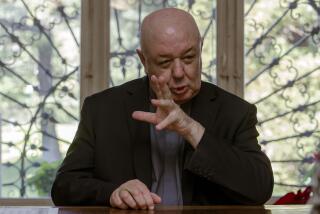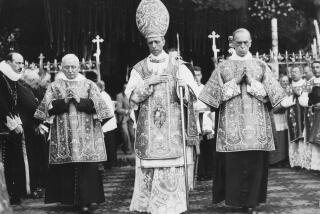Why the Vatican Condoned U.S. Aid to Stalin’s Army
- Share via
ATHENS, OHIO — In early September, the Russian Parliament overwhelmingly passed a new law sharply restricting the property rights and activities of non-mainstream religions. The law is clearly directed at foreign missionaries (many of them American) who have proliferated throughout Russia following the collapse of communism. The Clinton administration worries that the law indicates a return to the bad old days of Soviet-style religious repression. No doubt hoping to highlight his diplomatic skills in advance of his presidential campaign, Vice President Al Gore traveled to Moscow specifically to lobby Russian President Boris N. Yeltsin to exercise his executive veto. The visit was a failure: On Sept. 26, Yeltsin signed the legislation rather than face an inevitable override by the Duma.
This incident is merely the latest installment in the long-running drama of Russian-American clashes over religious freedom. More than a century ago, Washington protested czarist anti-Semitic policies; U.S. objections to communist-atheist repression of religion were a staple of Soviet-American quarrels from the time of Lenin through the Gorbachev era. In these clashes, Americans have generally seen themselves as defenders of religious freedom and the independence of churches against Russian authoritarian and statist traditions.
This has not always been the case, however. New documents discovered in the Soviet archives, dating from WWII, show that, at times, the story was more complex and that political pressure did not always flow from west to east.
On June 22, 1941, the Nazis invaded the U.S.S.R. Operation Barbarossa, as it was dubbed by the Germans, posed difficult dilemmas for U.S. diplomacy. In the still-neutral United States, many people viewed the clash between the dictatorships of Adolf Hitler and Josef Stalin with outright glee. The former U.S. ambassador to Moscow, William C. Bullitt, for instance, remarked that the Nazi-Soviet conflict amounted to a battle “between Lucifer and Satan.” Most Western military observers believed that the German army, fresh from its triumphs in Poland, France and the Balkans, would make short work of the Red Army.
President Franklin D. Roosevelt, however, stubbornly--and, as it turned out, rightly--rejected the assessments of his military experts and maintained that the Russian people would successfully resist the Nazi invaders, if only they were supported generously by the United States. So, from the first day of the war, he sought to extend “lend lease” assistance to the U.S.S.R., supplying Moscow with the material means to defeat Hitler.
A great many influential Americans, especially religious leaders, opposed giving any military assistance to the atheistic communists. Distrust of the Soviet Union was particularly strong among American Catholics. The Vatican had taken a consistently anti-communist line in the years since the Bolshevik Revolution of 1917. In March 1937, Pope Pius XI had issued an encyclical condemning Soviet atheism in the strongest possible terms and telling Catholics that they must not cooperate with communists in any endeavor, no matter how worthy. His successor, Pope Pius XII, was at least as ardently anti-communist and, although he condemned both Nazism and communism in strong terms, he clearly regarded the latter as the greater menace to religious freedom.
Throughout his presidency, Roosevelt was always deeply concerned with religious opinion. He knew that working-class Catholics represented a crucial bloc in his political coalition, and that many rank-and-file Catholics were descendants of East European immigrants who loathed Russian imperialism, whether Soviet or czarist. Somehow, Roosevelt reasoned, Catholics had to be persuaded that in order to defeat the Nazis and to protect U.S. security, they would have to swallow hard and acquiesce in assisting the Soviet war effort.
Roosevelt was astonishingly frank about these worries when, on Sept. 11, he met with with the Soviet ambassador to Washington, Konstantin Umanskii. According to the American record of the meeting, “the president explained in some detail the extreme difficulty of getting the necessary authority from Congress” for lend-lease assistance to the U.S.S.R. The reason for recalcitrance on Capitol Hill was not only the record of Soviet religious repression, but also “the prejudice or hostility to Russia and the unpopularity of Russia among large groups in this country who exercise great political power in Congress.”
The Soviet record of the talk, which Umanskii sent back to Moscow, is much clearer about who these supposed obstructionists were. “Roosevelt complained about the anti-Soviet intrigues of the church,” Umanskii wrote, “especially the Catholics and their people in Congress . . . [and] said that he sent his personal representative to the Vatican, [Myron] Taylor, once again to the pope with the fundamental goal of neutralizing the ‘in fact profascist’ influence of Catholics in the U.S.A. and to bring round the pope on the question of the U.S.S.R.” If Umanskii’s account is correct, this was, to say the least, an odd way for a U.S. president to refer to domestic critics.
Other than moral suasion, it was not clear what pressure Roosevelt could bring on the Vatican. Another Soviet document suggests, however, that the president was prepared to resort to stern measures to get his way. In October, Umanskii, who had returned to Moscow, explained to a high-level conference of Soviet officials that “the pope wanted to speak out against any country that entered into alliance with us. [But] Roosevelt called the Catholics to him and stated that [their] funds would be sequestered. As you see, we have the capacity for influence.”
Standing alone, Umanskii’s remarks make little sense. It is not clear, given the U.S. separation of church and state, just what funds Roosevelt could possibly have seized or withheld from the church. But a document from an entirely different source hints at an explanation. In the summer of 1941, Nazi intelligence agents operating in the Vatican reported to Berlin that, “Even before the war, the Vatican found itself in constant financial embarrassment. In the meantime, the largest contributors of money--the Netherlands, Belgium, France, Austria, Spain--have dropped out. Consequently, since the beginning of the war, the Vatican has regularly received a considerable sum from the U.S.A., which is described as money collected by American Catholics but which, in reality, is drawn from secret funds held by Roosevelt.”
This could easily be dismissed as nothing more than an intelligence rumor were it not for Umanskii’s report, which was apparently based on Roosevelt’s own comments. It is doubtful, though not impossible, that Roosevelt commanded a secret slush fund that he used to channel money to the Catholic Church. At any rate, no evidence has ever emerged of such a secret cache. It is quite possible, however, that Roosevelt let it be known through intermediaries that, if the pope were to forbid American Catholics to support U.S. assistance to Russia, or, worse yet, were he actually to endorse publicly the Nazi invasion of the U.S.S.R., then FDR might use the powerful tools of the presidency to hamper or even block the transfer of U.S. funds to Rome.
This new evidence casts a rather different light on Roosevelt’s wartime correspondence with Pius XII. In late August 1941, the president explained to the pope at some length that “the survival of Russia is less dangerous to religion, to the church as such, and to humanity in general than would be the survival of the German form of dictatorship.” Keeping in mind the possibility that FDR was prepared to wield financial pressure on the church, however indirectly, the next line sounds something like a veiled threat: “It is my belief that the leaders of all churches in the United States should recognize these facts clearly and should not close their eyes to these basic questions and by their present attitude on this question directly assist Germany in her present objectives.” Clearly, FDR believed that the Vatican was assisting the Nazis.
Pope Pius XII never did endorse the German invasion of the U.S.S.R., even though he continued to fear the consequences of a Soviet victory and communist domination of Europe. Most American Catholic leaders, though they remained implacably opposed to Soviet communism, either supported aid to Moscow or at least refrained from public opposition. Lend-lease support began flowing to Moscow in November 1941, playing a vital role in the Soviet war effort. Without more information, which may not even exist anymore, it is impossible to judge to what extent U.S. threats of financial pressure quieted church opposition.
This whole affair remains murky, but it shows that Roosevelt was prepared to bend the rules considerably when he was convinced that national security was at stake. The supposedly “impenetrable wall” separating church and state in this country can be breached from more than one direction; pressure can come from the government as well as from churches. At the very least, the incident might give Americans pause when they blithely judge other countries’ church-state arrangements.*
More to Read
Sign up for Essential California
The most important California stories and recommendations in your inbox every morning.
You may occasionally receive promotional content from the Los Angeles Times.













